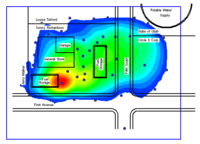GMS:Interpolating with 2D Scatter Points: Difference between revisions
From XMS Wiki
Jump to navigationJump to search
No edit summary |
No edit summary |
||
| Line 1: | Line 1: | ||
{{2D Scatter Point links}} | {{2D Scatter Point links}} | ||
Scatter point sets are used for interpolation to other data types such as TINs, grids, and meshes. A 2D grid can be created which will just enclose the scatter points by using the [[GMS:3D Scatter Point Module#Bounding Grid| | Scatter point sets are used for interpolation to other data types such as TINs, grids, and meshes. A 2D grid can be created which will just enclose the scatter points by using the [[GMS:3D Scatter Point Module#Bounding Grid|'''Bounding Grid''']] command in the ''Scatter Points'' menu. Interpolation is useful for such tasks as contouring or setting up input data to a model. Since no interpolation scheme is superior in all cases, several [[GMS:Interpolation|interpolation]] techniques are provided in GMS. | ||
The basic approach to performing an interpolation is to select an appropriate interpolation scheme and interpolation parameters, and then interpolate to the desired object using one of the [[GMS:Interpolation Commands|2D interpolation commands]]. | The basic approach to performing an interpolation is to select an appropriate interpolation scheme and interpolation parameters, and then interpolate to the desired object using one of the [[GMS:Interpolation Commands|2D interpolation commands]]. | ||
The interpolation options are selected using the [[GMS:2D Interpolation Options|Interpolation Options]] dialog accessed through the | The interpolation options are selected using the [[GMS:2D Interpolation Options|Interpolation Options]] dialog accessed through the '''Interp. Options''' command in the ''Interpolation'' menu. Once a set of options is selected, those options are used for all subsequent interpolation commands. | ||
{{Navbox GMS}} | {{Navbox GMS}} | ||
[[Category:2D Scatter Point]] | [[Category:2D Scatter Point]] | ||
